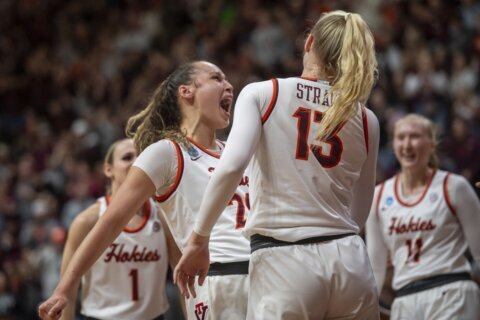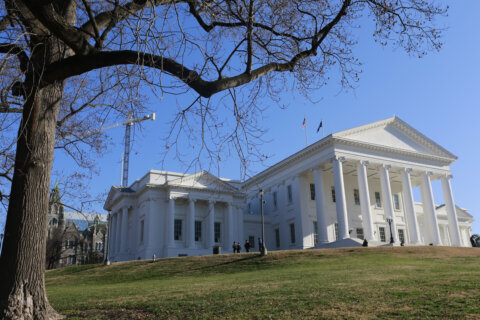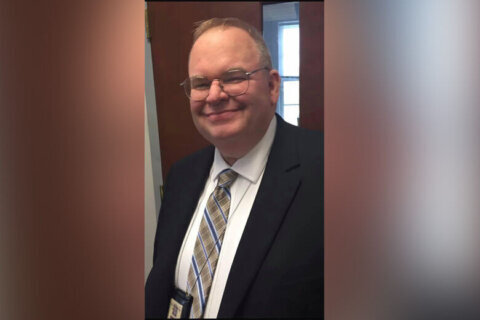▶ Watch Video: Local Matters: Virginia governor’s race neck-and-neck: CBS News poll
The Virginia governor’s race is but one state contest, an entire year before the midterms. So why are the nation’s political eyes all watching it so intensely? Because, as our poll finds, it’ll turn on the very issues voters across the country are facing: vaccines and mandates, the economy and jobs, feelings about Joe Biden and, for some, about Donald Trump, too.
And also because it looks close.
Democrat Terry McAuliffe, the former governor, leads Republican Glenn Youngkin by a narrow three points in the preferences of likely voters. McAuliffe hits 50% including voters leaning his way, but there are some clear warning signs for Democrats: Youngkin leads with independents, and his backers look more enthusiastic about voting and firmer in their choice. While Democrats are banking an early-vote lead, McAuliffe still needs to turn out most of the voters who came out for Mr. Biden last year.
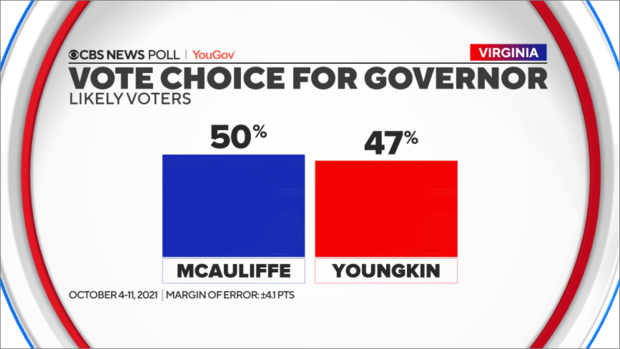
On issues, this race is shaping up to be about approaches to coronavirus versus the economy. McAuliffe has the advantage on COVID-related issues, like mask and vaccine mandates. Most voters statewide support vaccine mandates for Virginia businesses, putting them at odds with Youngkin’s position. Voters think McAuliffe would do a better job than Youngkin in handling vaccine issues, and more cite mandates as very motivating to their turnout than any other issue tested, also helping give McAuliffe an edge.
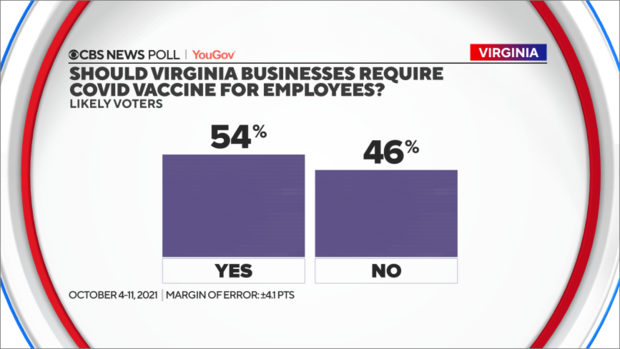
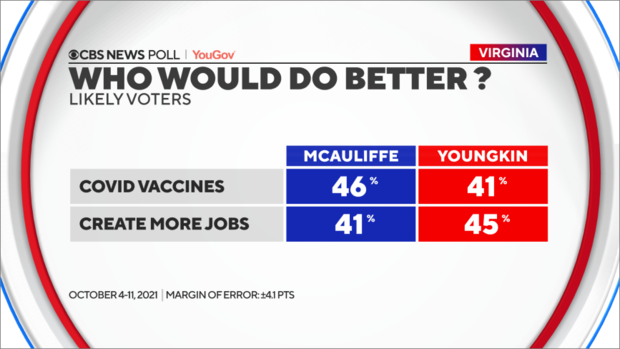
Youngkin leads among voters saying Virginia’s economy is a major factor in their vote and also has an edge when asked which candidate’s policies would create more jobs in the state. There may not be as much payoff for him in that, however, since most voters think Virginia’s economy is doing at least somewhat well.

The Biden and Trump factors
Two figures loom large in this race, though they’re not on the ballot: President Biden and former President Trump. Feelings about them are motivating many voters to turn out, and more appear to be expressing opposition than support for them.
Views of Mr. Biden may be helping Youngkin more than McAuliffe in motivating voters. Here’s how: Youngkin voters overwhelmingly disapprove of the job the president is doing, and more than eight in 10 feel McAuliffe agrees too much with Mr. Biden’s ideas and policies. Most Youngkin supporters are very motivated to turn out by their feelings about Mr. Biden — even more so than feelings about Mr. Biden are motivating McAuliffe voters (who largely approve of the president’s job handling).

The centrality of these views shows how this race has been infused with national debates, as much as it’s about local issues. Mr. Biden won Virginia by 10 points, but today, his disapproval number is a bit higher than his approval number among likely voters (a smaller and older group than all Virginians). Approximately one in eight of his 2020 voters in Virginia now disapprove of the job he’s doing — a pattern we see across the country.
Virginia independents broke for Biden last fall, but tend to disapprove today and currently back Youngkin, keeping this race close. Most independents say McAuliffe is more liberal than they would like, and about half say he supports Mr. Biden’s ideas and policies too much. By contrast, only four in 10 feel Youngkin is too conservative for them (a theme of McAuliffe’s campaign).
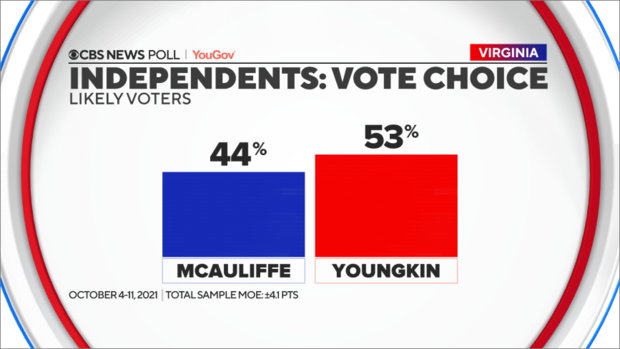
Donald Trump is also a factor in whether or not some voters turn out. And here too, more of McAuliffe’s voters are motivated by their feelings about Mr. Trump — presumably negative, since they overwhelmingly voted against him last year — than Youngkin’s backers are.
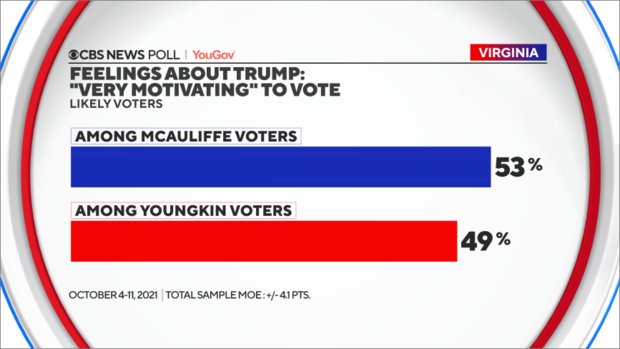
McAuliffe is trying to paint Youngkin as a “Trump wannabe,” and that resonates with Democrats — they feel Youngkin supports Mr. Trump’s ideas and policies too much. Independents, however, are more split: less than half agree, and in fact, they are slightly likelier to say that McAuliffe supports Mr. Biden too much than say Youngkin supports Mr. Trump too much.
Republicans are overwhelmingly backing Youngkin, though one in five say he does not support Mr. Trump’s ideas and policies enough.
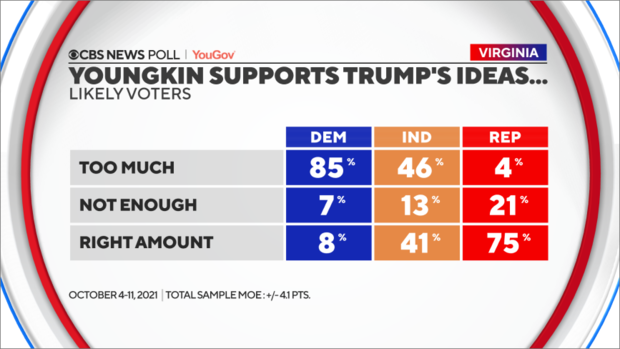
In yet another sign of how national politics casts its shadow on state races, most voters attribute their choice of governor, at least in part, to their feelings about the national parties. For instance, 74% of McAuliffe backers select opposition to the national Republican Party as a reason for their vote choice. That’s a bit higher than the 69% citing their opposition to the Virginia GOP.
Youngkin supporters are equally likely to cite their opposition to national Democrats and Virginia Democrats, but their expressed reasons illustrate the motivation negative partisanship provides. For example, 73% choose opposing national Democrats, while 63% choose supporting national Republicans. Even McAuliffe voters’ most commonly picked reason is opposition to Republicans — slightly ahead of supporting Democrats at the either national or state level.
Where it gets local
Taxes specifically are among the top issues motivating Youngkin supporters. They are twice as likely as McAuliffe backers to say that issue is “very motivating” for them to turn out, and across all issues asked about, Youngkin’s largest lead is among those citing taxes as a major factor.
Two in three likely voters favor eliminating Virginia’s 2.5% grocery tax, a change Youngkin has been emphasizing. Support for getting rid of the tax is driven by his voters and Republicans, but seven in 10n independents and about half of Democrats agree.
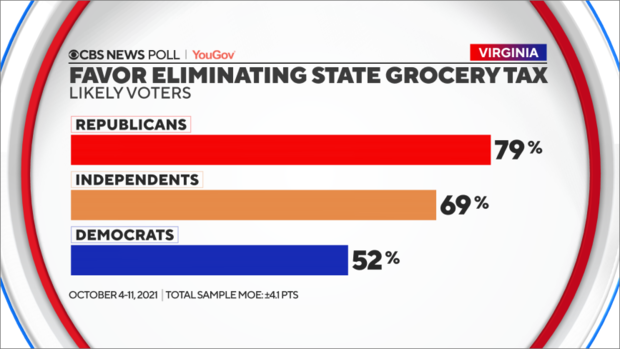
Youngkin also has a 10-point advantage on being seen as the candidate that would do more to reduce violent crime, another theme of his campaign and point of criticism of former Governor McAuliffe. Two-thirds of voters cite crime and public safety in the state as a major factor in their vote choice, driven by Youngkin supporters.
Republicans also appear to be energized by school curriculums, which has become a campaign issue. Among those who select “Virginia’s school curriculums on race and history” as a major factor in their vote choice, Youngkin leads McAuliffe by 20 points.
That said, voters give some overall evaluations of the state that seem at odds with an appetite for a shakeup in Richmond. About six in ten registered voters feel that things are going at least somewhat well in Virginia, and a similar number rate the state economy positively. A majority approve of the job the current governor, Ralph Northam, is doing. And McAuliffe himself is slightly above water when voters take a look back at his years in the governor’s mansion.
McAuliffe does have the edge on another issue in this campaign: abortion. He leads among voters who say abortion policy in Virginia is a major factor in their vote. Most voters in the state feel that abortion should be legal in most or all cases.
Enthusiasm and early voting
Despite McAuliffe’s lead, we see a couple of positive signs for Youngkin. First, the GOP base looks more excited to vote in this off-year election. Among registered voters who haven’t voted yet, 2020 Trump voters are 12 points more likely than Biden voters to say they’ll definitely vote this year (88% vs. 76%). And Youngkin supporters express slightly more enthusiasm about voting than McAuliffe supporters do. In fact, a third of McAuliffe’s voters, and a quarter of Democratic voters, wish their party had nominated someone else to run for governor this year, and these voters are markedly less enthusiastic about voting.
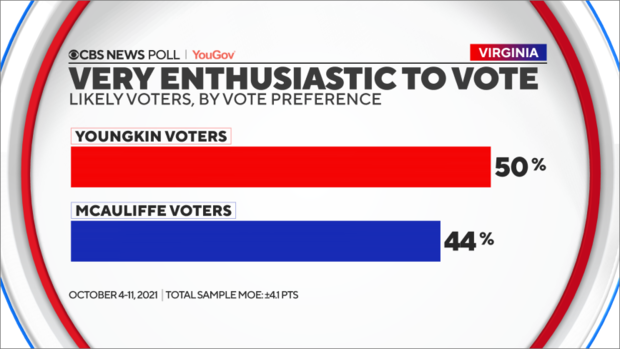
Second, McAuliffe appears to be more dependent than Youngkin on voters who haven’t entirely made up their minds yet. This small group — fewer than one in ten remaining voters — reports being unsure of their vote at first, but when asked what they would do if the election were today and they had to choose, prefer McAuliffe to Youngkin by three to one. While they lean toward a candidate, they’re also less likely than firmer supporters to show up at all.
This race also illustrates a familiar dynamic with respect to how people cast ballots these days. Democrats have banked an early lead from nearly 300,000 ballots already cast. Republicans, who tend to vote later and on Election Day, are poised to cut into it in the coming weeks. Voters who have already voted prefer McAuliffe by 24 points, but this early-vote margin is set to drop significantly, as Youngkin is neck-and-neck with McAuliffe among likely voters who have not cast their ballots. Many Republicans tell us they will vote in person at early vote centers over the next few weeks, with the bulk of Youngkin’s voters planning to come out on Election Day.
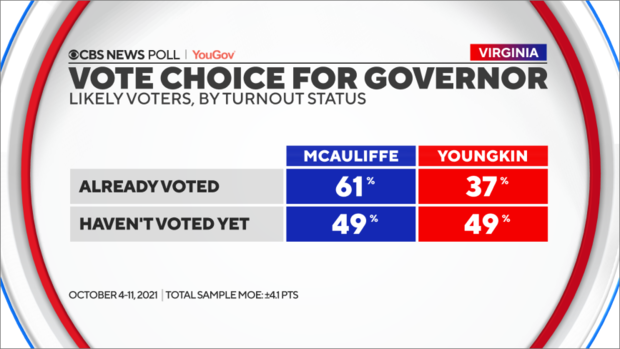
One big question is how big the groups of early and Election-Day voters will be. Democrats are hoping for a large early vote, given that McAuliffe leads among this group, especially those who plan to vote by mail. The pace of early voting has so far been much slower than it was in 2020, but there are still three weeks until Election Day. At this point in the 2020 campaign, over a third of all early votes had been cast. Under this trajectory, there could end up being fewer than one million early votes this year, compared to about 2.7 million last year. The current trend suggests voters are switching back to Election Day — Virginia’s predominant form of voting before 2020 — or that we’re headed for a low overall turnout.
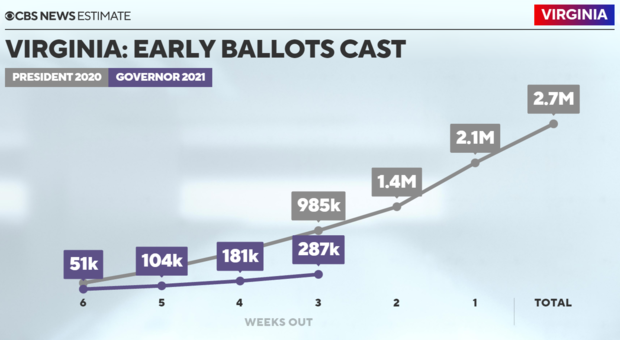
Vote preference and demographics
We see similar demographic breaks in voters’ preferences statewide as we did in 2020. Black voters are solidly behind McAuliffe, while White voters divide by education: college graduates prefer McAuliffe by 7 points, while Youngkin leads White voters without college degrees by 19 points.
There’s a large gender gap comparable in size to 2020, with women choosing McAuliffe by 14 points and men picking Youngkin by 9 points. This difference is driven by voters without college degrees, among whom men are going for Youngkin by over 30 points. By contrast, men and women with college degrees support McAuliffe by similar margins.
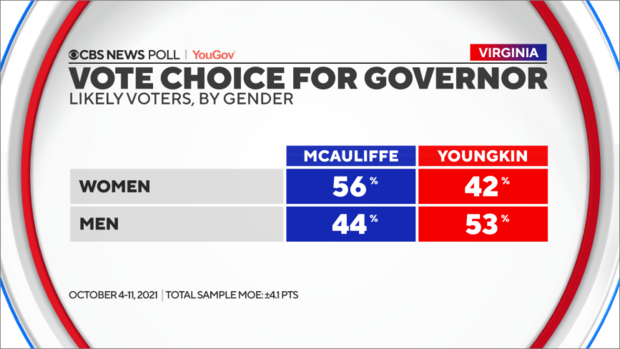
McAuliffe is racking up a huge margin in the suburbs of Washington, D.C., including Arlington and Fairfax County, while Youngkin’s support is more concentrated in the mountainous Western and central regions of the state.
A trend in Virginia politics over the past few election cycles is Democrats’ increasing reliance on more affluent voters living in the suburbs and more densely populated parts of the state. Along these lines, McAuliffe currently leads among voters with family incomes over $50,000 annually, while Youngkin is leading among those making less than that. The positive correlation between income and voting Democratic is especially pronounced among White voters.
Partisan loyalty and turnout scenarios
Another familiar pattern we see is party loyalty: the vast majority of 2020 voters — 93 to 94% — are sticking with the same party as before. That leaves very little crossover voting: only 5% of Biden voters support Youngkin, and just 4% of Trump voters support McAuliffe at the moment.
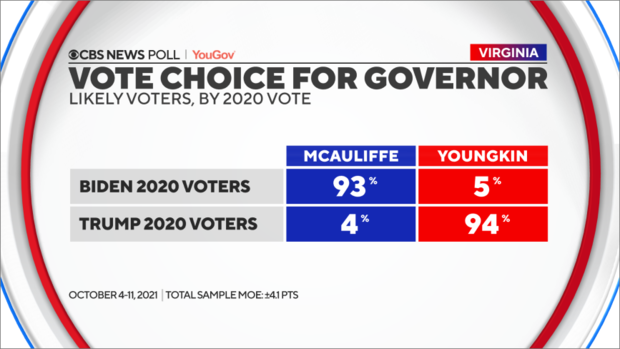
With such high rates of voting with the same party — a hallmark of our current, polarized climate — turning out one’s supporters eclipses persuasion in importance to the campaigns. While this race looks tight, particularly given Virginia’s recent trend blue, off-year race can be quite variable and difficult to precisely estimate: our data suggests that McAuliffe could open up a wider lead if turnout ends up being high, like it is in presidential years, but will be tight if turnout is lower than recent gubernatorial contests.
While Mr. Biden won Virginia by a comfortable 10 points last year, this year’s gubernatorial race looks closer partly because likely voters this year — who have a history of turning out in off-year elections and report they’ll vote again now — are a smaller, less Democratic group. They tend to be older and less racially diverse than registered voters overall and the presidential electorate. Our likely voter model takes this information into account, based on turnout patterns four years ago, and results in an estimate of a close race.
In order to understand a different, but plausible, scenario, we ran a turnout model approaching a presidential year. In this high-turnout turnout scenario, the electorate would be much younger — about four in 10 under 45, compared to three in 10 in our baseline model — and full of voters who did not vote in the last gubernatorial election. This electorate would be closer to Virginia’s broader pool of registered voters. Under this hypothetical electorate, and using voters’ current preferences by demographic group, we would estimate that McAuliffe’s margin would grow to a more decisive 8 points.

This CBS News survey was fielded by YouGov with a representative sample of 1,040 registered voters in Virginia interviewed between October 4-11, 2021. This sample was weighted according to gender, age, race, and education based on the U.S. Census American Community Survey, and the U.S. Census Current Population Survey, as well as 2020 Presidential vote. “Likely voters” — respondents’ relative probabilities of voting — were determined using a regression model that incorporates current, self-reported intentions to vote, along with individual-level and aggregate data about voters in Virginia, such as demographics and vote history. The margin of error for the total sample of likely voters is ±4.1 points.

